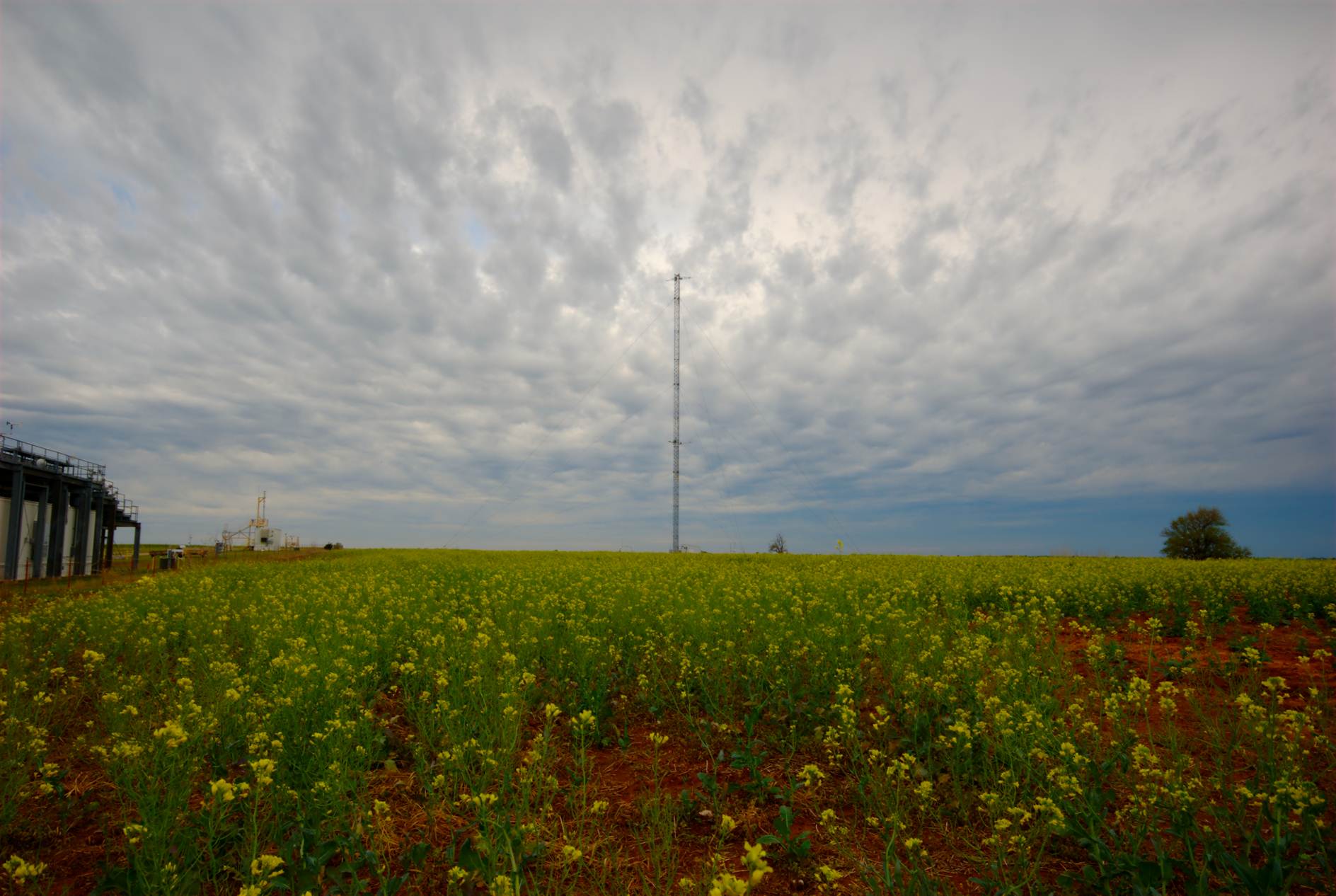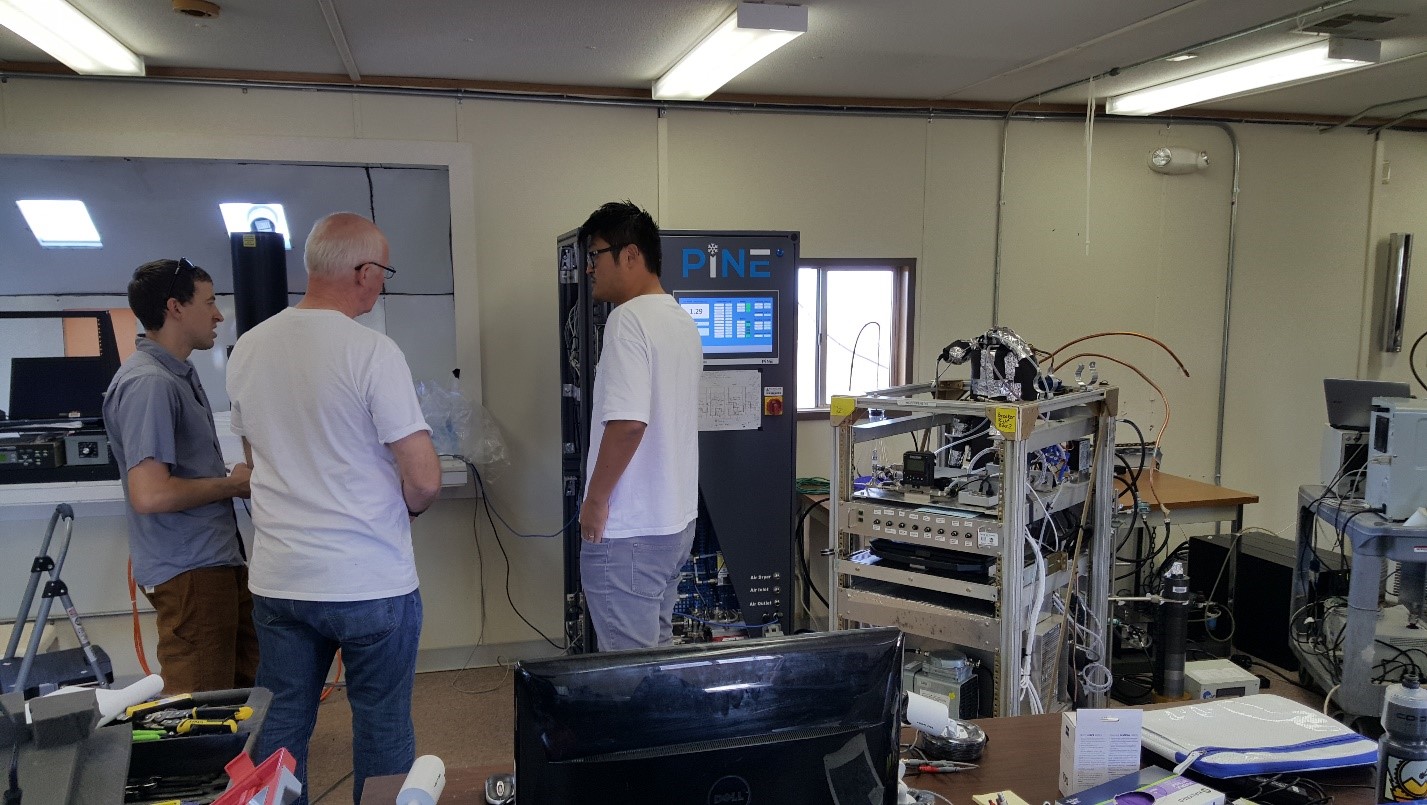Small Is Beautiful, Part 3: Cracking the Mysteries of Atmospheric Ice
Published: 24 March 2020
Researchers in the stormy Great Plains study particles involved in ice crystal formation
This is the third and final article in a series about small campaigns in 2019 at ARM’s Southern Great Plains atmospheric observatory.

A string of 2019 small field campaigns at the Southern Great Plains (SGP) atmospheric observatory looked at the science enabled by tethered balloon systems and efficient ground-instrument networks.
The Atmospheric Radiation Measurement (ARM) user facility, funded by the U.S. Department of Energy (DOE), manages the SGP.
ARM defines small campaigns as those that cost the facility less than $300,000. They often involve guest instruments and usually require fewer instruments and less time than larger campaigns, but still address important science questions.
Beyond balloons and instrument networks, two small campaigns in 2019 focused on ice-nucleating particles (INPs).
Cloud droplets use such particles as a nucleus. Just a few out of every million freeze into ice crystals, and scientists want to understand why.
INPs can originate from sea spray, soot from biomass burning, bacteria, fungi, or carbon-rich organic dusts generated during tilling and harvesting agricultural land.
Wherever they originate, INPs affect cloud-aerosol interactions, precipitation, and climate—and they are not well understood.
The gap in understanding is partly because INPs are difficult to observe and study. There is a big need for more lab and field experiments, including targeted sampling within clouds.
There are also so many unanswered questions. For instance, what is the molecular identity of active INP sites? What are the relevant surface features for ice nucleation? How do biological ice nuclei contribute?
In spring and summer particularly, the SGP is a good place to study INPs. In addition to reliably stormy weather, there are intriguing seasonal soil disturbances in the region that may be important for the production of INPs.
Above all, the SGP is heavily instrumented and reflects almost three decades of archived ARM data, making data comparisons easy.
Closure Measurements
“This pilot study will give us an idea of the underlying parameters we should be focusing on.”
Daniel Knopf, lead scientist of the October 2019 Aerosol-Ice Formation Closure Pilot Study at the SGP
During three weeks in October 2019, atmospheric chemist Daniel Knopf of Stony Brook University in New York led the field portion of a pilot-study campaign to improve how INPs are represented in earth system models.
The chief goal of the Aerosol-Ice Formation Closure Pilot Study was to close the data gaps between observations and the predicted rates of ice formation by particle species, such as a certain mineral dust. The goal means achieving what scientists like Knopf call a “closure measurement.”
It will take months of data analyses well into 2020 before knowing what the next steps are, he says, and to learn how the various ice formation parameterizations―simplified representations― perform in models.
However, “we tested our predictive ability,” says Knopf. “This pilot study will give us an idea of the underlying parameters we should be focusing on.”
The researchers might focus on more laboratory experiments or go back into the field with an expanded suite of instruments.
In the pilot study, industry-standard gear from both Knopf and the SGP sampled particles and collected data on aerosol composition, mixing states, and INP concentrations.
Whatever happens, the next field experiment will at least require an improved inlet stack that captures and measures larger particles—those above 1 micrometer in diameter or so, says Knopf, “and maybe up to 10 micrometers.”
He suspects that particles larger than those traditionally measured may turn out to “dominate ice nucleation.”
Once analyses of the 2019 SGP data are done, he says, “we will learn a lot” about the obstacles to having a more precise ice nucleation parameterization for ice and cloud models.
Achieving a closure measurement the first time out in a field campaign would be highly desirable. But if that is not the result, adds Knopf, “we will definitely learn how to approach this goal in future studies.”
Joining him as campaign co-investigators were researchers from Colorado State, Purdue, West Texas A&M, and Carnegie Mellon universities; the universities of Wyoming and Illinois; and NASA’s Goddard Institute for Space Studies.
Catching Ice-Nucleating Particles

Naruki Hiranuma (aka Seonggi Moon), an expert in advanced aerosol measurement techniques from West Texas A&M University, was a co-investigator in Knopf’s campaign. At the same time, he led an INP campaign of his own.
Both campaigns took place in a gear-packed trailer—a Guest Instrument Facility—at the SGP’s Central Facility.
In October and November 2019, Hiranuma led what he called Examining Ice Nucleating Particles (ExINP). This campaign provided the first automated and continuous measurements of ambient INP concentrations—for 45 days straight and at intervals of roughly every six minutes.
INPs are “the elephant in the closet” for aerosol researchers, says Hiranuma. “Everyone knows even a small amount of INPs in the atmosphere has a significant influence on cloud formation, precipitation, and―ultimately―our climate. But measurements are patchy.”
Out of many particles in the atmosphere, just a few might be INPs, he adds. “They are that needle in a haystack.”
Hiranuma’s work, supplemented by ARM data from instruments at the SGP, involved the first field deployment of PINE, the Portable Ice Nucleation Experiment chamber.
The one-of-a-kind device makes artificial clouds and uses aerosol particle detectors to monitor the abundance and characteristics of INPs.
PINE is a miniature version of a laboratory chamber housed at the Karlsruhe Institute of Technology in Germany and co-developed at the University of Leeds in the United Kingdom.
The PINE device deployed at the SGP is the first commercialized version and the only one in the United States. It is about the size of a refrigerator, weighs 400 pounds, and has a 10-liter chamber inside that can simulate the reduced temperatures and pressures found in the atmosphere.
The device is automated in a way that measures INP concentrations at different temperatures.
Speedy PINE

During Hiranuma’s campaign, PINE collected ambient air and aerosols through an exterior inlet. After a dryer stripped away ambient moisture, PINE subjected the dry particles and controlled moisture to an expansion in the chamber. Temperature and pressure were reduced to simulate conditions at the top of the atmosphere.
The result was a representation of how such particles behave in both the upward drafts of clouds and at the top of clouds.
The cloud top is where ice can collide and aggregate, and where particles can get heavy enough to fall back to Earth as rain, snow, hail, or drizzle.
“Ice is really important” for those reasons, says Hiranuma, but also because it absorbs, reflects, and scatters solar radiation.
Meanwhile, getting INP data every six minutes attains an operational speed “impossible before PINE came on the market,” he says.
PINE can be operated remotely, with minimal oversight. From his laboratory in west Texas, says Hiranuma, he can operate and oversee multiple PINE devices.
All these factors―as well as his team’s success at measuring INPs for 45 days in a row at the SGP, he says―make PINE “an ideal instrument for remote locations” such as those ARM maintains.
Future INP Campaigns

Going forward, ARM approved a 45-day PINE campaign from May 11 to June 21, 2020, at its Eastern North Atlantic atmospheric observatory. Another 45-day PINE campaign will take place in the fall of 2020 at ARM’s North Slope of Alaska atmospheric observatory.
With more field validations at ARM sites, says Hiranuma, PINE might prove to be “a meaningful game-changer.”
At the SGP, INP investigations will continue in the fall of 2020.
For a few weeks in September or October, a small ARM field campaign called Agricultural Ice Nuclei at SGP (AGINSGP) will look into the sources and variability of INP concentrations at the observatory.
One focus will be understanding how dusty air caused by seasonal agricultural practices contributes to airborne INPs.
A second, related short campaign―a continuation of the first―will launch in the spring of 2021 at the SGP.
AGINSGP is led by Susannah Burrows, an atmospheric scientist at Pacific Northwest National Laboratory (PNNL) in Washington state. Her research includes INPs in both marine and agricultural environments.
For the first time in a field setting, the campaign will use a single-particle mass spectrometer and an ice nucleation chamber. Both instruments are from the Environmental Molecular Sciences Laboratory, a DOE scientific user facility located on the PNNL campus.
“This combination of instruments,” says Burrows, “will provide unique insights into the identity of particles that act as INPs in this agricultural region.”
Keep up with the Atmospheric Observer
Updates on ARM news, events, and opportunities delivered to your inbox
ARM User Profile
ARM welcomes users from all institutions and nations. A free ARM user account is needed to access ARM data.


















